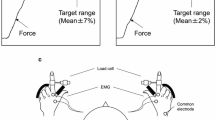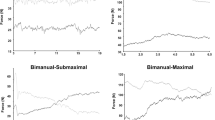Abstract
Hemispheric brain injury resulting from a stroke is often accompanied by muscle weakness in contralateral limbs. In neurologically intact subjects, appropriate motoneuronal recruitment and rate modulation are utilized to optimize muscle force production. In the present study, we sought to determine whether weakness in an affected hand muscle in stroke survivors is partially attributable to alterations in the control of muscle activation. Specifically, our goal was to characterize whether the surface EMG amplitude was systematically larger as a function of (low) force in paretic hand muscles as compared to contralateral muscles in the same subject. We tested a multifunctional muscle, the first dorsal interosseous (FDI), in multiple directions about the second metacarpophalangeal joint in ten hemiparetic and six neurologically intact subjects. In six of the ten stroke subjects, the EMG–force slope was significantly greater on the affected side as compared to the contralateral side, as well as compared to neurologically intact subjects. An unexpected set of results was a nonlinear relation between recorded EMG and generated force commonly observed in the paretic FDI, even at very low-force levels. We discuss possible experimental as well as physiological factors that may contribute to an increased EMG–force slope, concluding that changes in motor unit (MU) control are the most likely reasons for the observed changes.





Similar content being viewed by others
References
Bilodeau M, Cincera M, Arsenault AB, Gravel D (1997) Normality and stationarity of EMG signals of elbow flexor muscles during ramp and step isometric contractions. J Electromyogr Kinesiol 7(2):87–96
Blaschak MJ, Powers RK, Rymer WZ (1988) Disturbances of motor output in a cat hindlimb muscle after acute dorsal spinal hemisection. Exp Brain Res 71(2):377–387
Farina D, Holobar A, Merletti R (2010) Enoka RM decoding the neural drive to muscles from the surface electromyogram. Clin Neurophysiol 121:1616–1623
Gemperline JJ, Allen S, Walk D, Rymer WZ (1995) Characteristics of motor unit discharge in subjects with hemiparesis. Muscle Nerve 18(10):1101–1114
Hachisuka K, Umezu Y, Ogata H (1997) Disuse muscle atrophy of lower limbs in hemiplegic patients. Arch Phys Med Rehabil 78(1):13–18
Heckathorne CW, Childress DS (1981) Relationship of the surface electromyogram to the force, length, velocity and contraction rate of the cineplastic human biceps. Am J Phys Med 60:1–19
Hu X, Suresh AK, Li X, Rymer WZ, Suresh NL (2012) Impaired motor unit control in paretic muscle post stroke assessed using surface electromyography: a preliminary report. In: Conference Proceedings of IEEE Engineering in Medicine and Biology Society, pp 4116–4119. PMID: 23366833
Jakobsson F, Edstrom L, Grimby L, Thornell LE (1991) Disuse of anterior tibial muscle during locomotion and increased proportion of type II fibres in hemiplegia. J Neurol Sci 105(1):49–56
Jakobsson F, Grimby L, Edstrom L (1992) Motoneuron activity and muscle fibre type composition in hemiparesis. Scand J Rehabil Med 24(3):115–119
Klein CS, Brooks D, Richardson D, McIIroy WE, Bayley MT (2010) Voluntary activation failure contributes more to plantar flexor weakness than antagonist coactivation and muscle atrophy in chronic stroke survivors. J Appl Physiol 109(5):1337–1346
Lawrence JH, De Luca CJ (1983) Myoelectric signal versus force relationship in different human muscles. J Appl Physiol 54(6):1653–1659
Milner-Brown HS, Stein RB (1975) The relation between the surface electromyogram and muscular force. J Physiol 246:549–569
Rosenfalck A, Andreassen S (1980) Impaired regulation of force and firing pattern of single motor units in patients with spasticity. J Neurol Neurosurg Psychiatry 43(10):907–916
Ryan AS, Dobrovolny CL, Smith GV, Silver KH, Macko RF (2002) Hemiparetic muscle atrophy and increased intramuscular fat in stroke patients. Arch Phys Med Rehabil 83(12):1703–1707
Scelsi R, Lotta S, Lommi G, Poggi P, Marchetti C (1984) Hemiplegic atrophy. Morphological findings in the anterior tibial muscle of patients with cerebral vascular accidents. Acta Neuropathol 62(4):324–331
Suresh NL, Stiller R, Rymer WZ (2010) Abnormal motor unit firing properties in stroke hand muscle. Society for Neuroscience, Chicago
Suresh NL, Li X, Zhou P, Rymer WZ (2011) Examination of motor unit control properties in stroke survivors using surface EMG decomposition: a preliminary report. In: Proceedings of IEEE Engineering in Medicine and Biology Society, pp 8243–8246. PMID: 22256256
Tang A, Rymer WZ (1981) Abnormal force–EMG relations in paretic limbs of hemiparetic human subjects. J Neurol Neurosurg Psychiat 44(8):690–698
Thomas CK, del Valle A (2001) The role of motor unit rate modulation versus recruitment in repeated submaximal voluntary contractions performed by control and spinal cord injured subjects. J Electromyogr Kinesiol 11(3):217–229
Zijdewind I, Thomas CK (2003) Motor unit firing during and after voluntary contractions of human thenar muscles weakened by spinal cord injury. J Neurophysiol 89(4):2065–2071
Author information
Authors and Affiliations
Corresponding author
Rights and permissions
About this article
Cite this article
Suresh, N.L., Concepcion, N.S., Madoff, J. et al. Anomalous EMG–force relations during low-force isometric tasks in hemiparetic stroke survivors. Exp Brain Res 233, 15–25 (2015). https://doi.org/10.1007/s00221-014-4061-3
Received:
Accepted:
Published:
Issue Date:
DOI: https://doi.org/10.1007/s00221-014-4061-3




